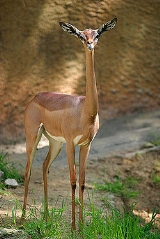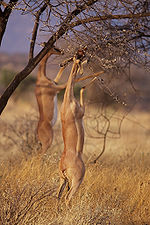
Gerenuk
Encyclopedia
The Gerenuk also known as the Waller's Gazelle, is a long-necked species
of antelope
found in dry bushy scrub
and steppe
in East Africa
, from Somalia and eastern Ethiopia through northern and eastern Kenya to northeastern Tanzania. The word Gerenuk comes from the Somali language
, meaning “giraffe-necked” Gerenuk are sometimes also called the Giraffe-necked Antelope. It is the only member of the genus
Litocranius.
Gerenuks have a small head for their body, but their eyes and ears are big. Unlike females, males have horn
s and a more muscular neck. They are brown on their back, and lighter underneath. They have short, black tails. From head to tail, the gerenuk is around 150 cm long. Males are a little taller than females, ranging from 89-105 cm, and the females are 80-100 cm. The male is also heavier than the female, weighing at 45 kg, and females are 30 kg.
 Gerenuks eat food from higher places than most other gazelle
Gerenuks eat food from higher places than most other gazelle
s and antelopes. They do this by standing up on their hind legs, and stretching out their long necks to get food off of tall bushes or small trees. Most of their diet is made up of leaves and shoots of shrubs and trees, but also includes buds, flower
s, fruit
, and herbaceous plants . Gerenuks do not appear to drink water; they get enough water
from the plants they eat. Because of this, they can survive in very dry habitat
s.
Gerenuk reproduce throughout the year. Females reach sexual maturity
at around one year, and males reach sexual maturity at 1.5 years, although in the wild they may only be successful after acquiring a territory (perhaps 3.5 years). The gestation period
is about seven months. They are born one at a time, weighing about 3 kg at birth. Gerenuk can live thirteen years or more in captivity, and at least eight years in the wild.
Species
In biology, a species is one of the basic units of biological classification and a taxonomic rank. A species is often defined as a group of organisms capable of interbreeding and producing fertile offspring. While in many cases this definition is adequate, more precise or differing measures are...
of antelope
Antelope
Antelope is a term referring to many even-toed ungulate species indigenous to various regions in Africa and Eurasia. Antelopes comprise a miscellaneous group within the family Bovidae, encompassing those old-world species that are neither cattle, sheep, buffalo, bison, nor goats...
found in dry bushy scrub
Shrubland
Shrubland, scrubland, scrub or brush is a plant community characterized by vegetation dominated by shrubs, often also including grasses, herbs, and geophytes. Shrubland may either occur naturally or be the result of human activity...
and steppe
Steppe
In physical geography, steppe is an ecoregion, in the montane grasslands and shrublands and temperate grasslands, savannas, and shrublands biomes, characterized by grassland plains without trees apart from those near rivers and lakes...
in East Africa
East Africa
East Africa or Eastern Africa is the easterly region of the African continent, variably defined by geography or geopolitics. In the UN scheme of geographic regions, 19 territories constitute Eastern Africa:...
, from Somalia and eastern Ethiopia through northern and eastern Kenya to northeastern Tanzania. The word Gerenuk comes from the Somali language
Somali language
The Somali language is a member of the East Cushitic branch of the Afro-Asiatic language family. Its nearest relatives are Afar and Oromo. Somali is the best documented of the Cushitic languages, with academic studies beginning before 1900....
, meaning “giraffe-necked” Gerenuk are sometimes also called the Giraffe-necked Antelope. It is the only member of the genus
Genus
In biology, a genus is a low-level taxonomic rank used in the biological classification of living and fossil organisms, which is an example of definition by genus and differentia...
Litocranius.
Gerenuks have a small head for their body, but their eyes and ears are big. Unlike females, males have horn
Horn (anatomy)
A horn is a pointed projection of the skin on the head of various animals, consisting of a covering of horn surrounding a core of living bone. True horns are found mainly among the ruminant artiodactyls, in the families Antilocapridae and Bovidae...
s and a more muscular neck. They are brown on their back, and lighter underneath. They have short, black tails. From head to tail, the gerenuk is around 150 cm long. Males are a little taller than females, ranging from 89-105 cm, and the females are 80-100 cm. The male is also heavier than the female, weighing at 45 kg, and females are 30 kg.

Gazelle
A gazelle is any of many antelope species in the genus Gazella, or formerly considered to belong to it. Six species are included in two genera, Eudorcas and Nanger, which were formerly considered subgenera...
s and antelopes. They do this by standing up on their hind legs, and stretching out their long necks to get food off of tall bushes or small trees. Most of their diet is made up of leaves and shoots of shrubs and trees, but also includes buds, flower
Flower
A flower, sometimes known as a bloom or blossom, is the reproductive structure found in flowering plants . The biological function of a flower is to effect reproduction, usually by providing a mechanism for the union of sperm with eggs...
s, fruit
Fruit
In broad terms, a fruit is a structure of a plant that contains its seeds.The term has different meanings dependent on context. In non-technical usage, such as food preparation, fruit normally means the fleshy seed-associated structures of certain plants that are sweet and edible in the raw state,...
, and herbaceous plants . Gerenuks do not appear to drink water; they get enough water
Water
Water is a chemical substance with the chemical formula H2O. A water molecule contains one oxygen and two hydrogen atoms connected by covalent bonds. Water is a liquid at ambient conditions, but it often co-exists on Earth with its solid state, ice, and gaseous state . Water also exists in a...
from the plants they eat. Because of this, they can survive in very dry habitat
Habitat
* Habitat , a place where a species lives and grows*Human habitat, a place where humans live, work or play** Space habitat, a space station intended as a permanent settlement...
s.
Gerenuk reproduce throughout the year. Females reach sexual maturity
Sexual maturity
Sexual maturity is the age or stage when an organism can reproduce. It is sometimes considered synonymous with adulthood, though the two are distinct...
at around one year, and males reach sexual maturity at 1.5 years, although in the wild they may only be successful after acquiring a territory (perhaps 3.5 years). The gestation period
Gestation period
For mammals the gestation period is the time in which a fetus develops, beginning with fertilization and ending at birth. The duration of this period varies between species.-Duration:...
is about seven months. They are born one at a time, weighing about 3 kg at birth. Gerenuk can live thirteen years or more in captivity, and at least eight years in the wild.
Subspecies
- Southern Gerenuk Litocranius walleri walleri
- Northern Gerenuk Litocranius walleri sclateri
External links
- http://www.allposters.com/-sp/-Gerenuk-Litocranius-Walleri-Feeding-Samburu-National-Reserve-Kenya-Posters_i4072537_.htm
- http://www.britannica.com/eb/article-9036539/gerenuk
- http://www.endangeredandrareanimals.com/gerenuk.htm

